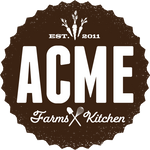Whole Grain for Whole Nutrition: Health Benefits of Whole Grains

In celebration of the launch of our Acme Whole Grain Bakery Box and our second bakery box challenge, we wanted to take a moment to talk about whole grains and what makes them so nutritious.
First off, what makes a whole grain whole? Simply put, whole grains contain all three parts of the grain kernel. Refined grains contain only one part of the grain—the endosperm—as the other two parts are stripped away in the refining process. Enriched grains are just refined grains with some of the nutrients lost during processing replaced.
Health Benefits of Whole Grain
Each part of the grain has health benefits, so by consuming all three parts you are getting the full nutrition of the grain. Here are the three parts of a grain kernel and the nutrients they contain:
- The bran is the fiber-rich outer layer of the grain that contains B vitamins, iron, copper, zinc, magnesium, antioxidants, and phytochemicals. Phytochemicals are natural chemical compounds in plants that have been researched for their role in disease prevention. Bran and fiber slow the breakdown of starch into glucose—thus helping to maintain regular blood sugar rather than causing sharp spikes. Fiber also helps to lower cholesterol and to help move waste through the digestive tract. Fiber may also help prevent the formation of small blood clots that can trigger heart attacks or strokes.
- The endosperm is the interior layer that holds carbohydrates, protein, and small amounts of some B vitamins and minerals. This is the only part of the grain left in refined and enriched grains.
- The germ is the core of grain and is rich in healthy fats, vitamin E, B vitamins, phytochemicals, and antioxidants. Phytochemicals and essential minerals such as magnesium, selenium, and copper found in whole grains may protect against some cancers.

If whole grains are so much healthier, why do so many products and recipes use refined grains? Milling leaves only the soft, easy-to-digest endosperm. Without the fibrous bran, this makes refined grains easier to chew. The germ is removed in milling because the fat it contains can limit the shelf life of processed wheat products.
Refined flour is fluffy and does help to make airy and light pastries and breads—but the refining process also strips away more than half of wheat’s B vitamins, 90 percent of vitamin E, and nearly all of the fiber. Although some nutrients may be added back in by enrichment and fortification after refining, other health-promoting components of whole grains such as phytochemicals are unable to be replaced.
Incorporating Whole Grains in Your Diet
Swapping out refined grains for whole grains when possible is a great way to get all the benefits of whole grains. Some whole grains you may consider incorporating into your baking and diet: barley, brown rice, buckwheat, bulgur (cracked wheat), millet, oats, popcorn, wild rice, quinoa, spelt, teff, sorghum, kamut, and whole-wheat bread, pasta and crackers.
If whole grains are so much healthier, why do so many products and recipes use refined grains? Milling leaves only the soft, easy-to-digest endosperm. Without the fibrous bran, this makes refined grains easier to chew. The germ is removed in milling because the fat it contains can limit the shelf life of processed wheat products.
Refined flour is fluffy and does help to make airy and light pastries and breads—but the refining process also strips away more than half of wheat’s B vitamins, 90 percent of vitamin E, and nearly all of the fiber. Although some nutrients may be added back in by enrichment and fortification after refining, other health-promoting components of whole grains such as phytochemicals are unable to be replaced.
Incorporating Whole Grains in Your Diet
Swapping out refined grains for whole grains when possible is a great way to get all the benefits of whole grains. Some whole grains you may consider incorporating into your baking and diet: barley, brown rice, buckwheat, bulgur (cracked wheat), millet, oats, popcorn, wild rice, quinoa, spelt, teff, sorghum, kamut, and whole-wheat bread, pasta and crackers.

Our Whole Grain Bakery Box is also a great way to learn 8 tasty baked good recipes full of whole grains! Order your Whole Grain Bakery Box by Wednesday, February 24 at midnight so you don’t miss out on these recipes and the opportunity to win prizes in our Bakery Box Challenge!
Happy baking and warm wishes,
– Your Acme Team
Sources:
Harvard T.H. Chan School of Public Health – “The Nutrition Source: Whole Grains”
Mayo Clinic – “Whole grains: Hearty options for a healthy diet”

